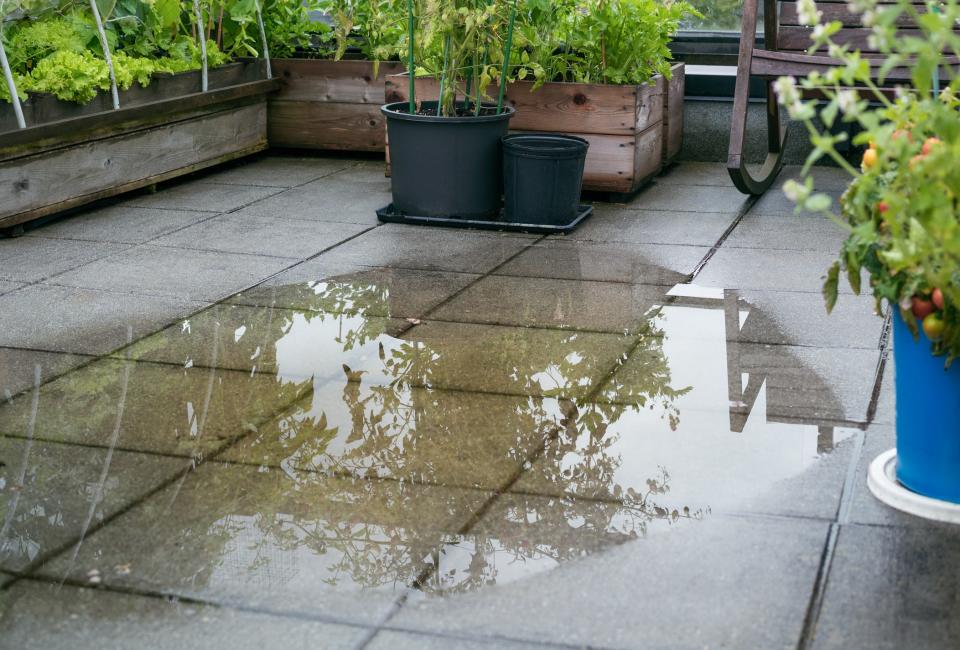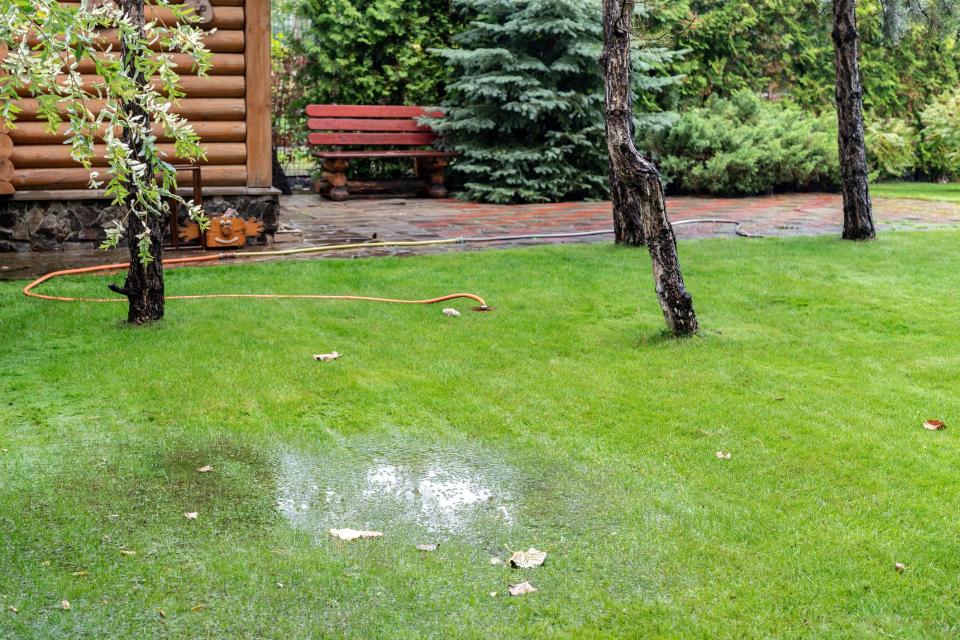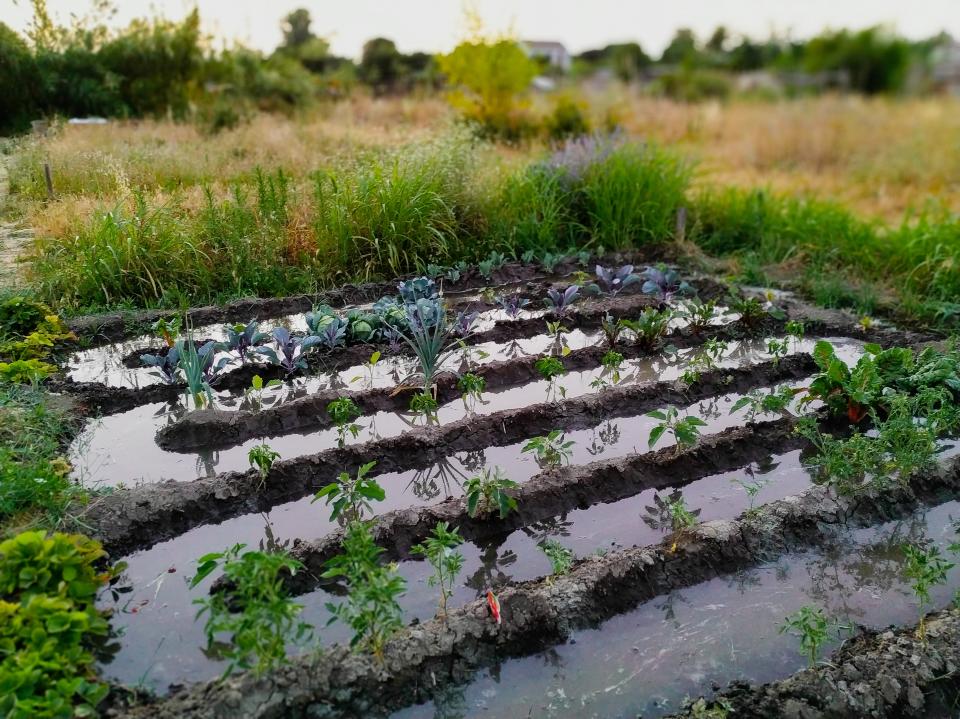Why Rain Gardens Are the Sustainable and Striking Feature Your Yard Needs

Illustration: Julia Abbonizio/Getty Images
Impervious surfaces, like parking lots, driveways, and walkways, make it difficult for stormwater to flow toward soil and seep into the ground. But by including rain gardens in your landscape design, this becomes less of a problem. Further, you’ll enjoy several environmental benefits when you include one in your lawn, like soaking up excessive stormwater on your property and containing runoff from pollutants and pesticides. Of course, there is also the beauty of adding more garden space to your yard.
You may have heard of residential rain gardens but don’t really get what makes it different from other landscape designs. Below, AD covers everything you need to know about these yard features to help you get started before designing your own rain garden.
What is a rain garden?
To the untrained eye, a rain garden might look similar to any other ornamental garden or intentionally planted space. “It may contain ornamental plants, native plans, or food growing plants,” explains Kory Russel, an assistant professor of landscape architecture and environmental studies at the University of Oregon. However, the primary difference in this garden feature from others is the intent.
Rain gardens are designed to capture and filter stormwater before releasing it back into the soil. Not only is this beneficial to the plants in your yard, it can eliminate flooded areas in your landscape design. “The goal of a rain garden is really about infiltrating runoff from from whatever buildings or hardscapes are around it,” Russel adds.
How do rain gardens work?

Patio drain clogged and flooded after heavy rain.
In an urban or suburban setting, hard surfaces like asphalt parking lots don’t allow the soil to soak up stormwater (another term for the water that pours out your gutters and downspouts during a rainstorm). That stormwater runoff, if not absorbed into the earth or diverted into a storm drain, needs to go somewhere. That’s where rain gardens come into play. Usually planted in shallow depressions, water can be diverted to them, where they soak up rain as it falls, then dry out after precipitation events.
What are the benefits of rain gardens?
Rain gardens provide a multitude of environmental benefits for your property and surrounding community.
Stormwater management is a huge advantage of having your own rain garden. If stormwater isn’t carried away or soaked into the ground, it can cause flooding where it lands or dikes. Along the way, that rainwater runoff picks up and carries a nasty concoction of any substance it passes: pesticides, fertilizer, dirt, dog poop, pollutants, and literally anything else lightweight or small enough to be carried by water.
Rain gardens help absorb that stormwater and in the process reduce flood risk, improve water quality in nearby waterways, and help recharge groundwater.
They also create new habitat for local wildlife. And considering “we’re going through a mass extinction event and, unfortunately, we’re losing a lot of species because of things like climate change and development,” every bit helps, says Jake Fox, the project director and landscape architect at Waterstreet Studio in Charlottesville, Virginia.
Do rain gardens attract mosquitoes?
In short, rain gardens won’t attract mosquitoes if they’re designed and maintained properly, as the rainwater should infiltrate into the ground fast enough.
“If it’s got standing water long enough for mosquitoes to breed in it, then it probably is not the appropriate soil type for a rain garden,” Russel notes.
How to set up a rain garden
Step 1: Select the location of your rain garden
Generally, you want to place a rain garden in a location where water will easily flow into from downspouts, driveways, or other points. Russel suggests rain gardens be used as edging (along fences or curbs) or to break up turf grass lawn space.
Any soil in which a rain garden is planted is naturally going to be rather soggy until it dries up. Because of that, you want your rain garden to be at least ten feet away from the foundation or any buildings.
“That can definitely be an issue if you’ve got a really small yard,” Russel notes. He adds that “you want to design [the rain garden] so the area in which the water is going into will be similar to a berm that is going to catch and hold that water to allow it to infiltrate the ground.”
Another place you shouldn’t place a rain garden is on a slope. “Typically, rain gardens work best on something that’s nearly flat,” Russel explains. “If the slope is greater than 12% or similar, you probably don’t want a rain garden.” That could make your rain garden an erosion risk.
Before planting, Fox suggests contacting your local utility marking services to avoid existing infrastructure. “That’s definitely a really good early step to understand what’s going on under the ground,” he explains. “Especially with older buildings, you can get all kinds of stuff under there,” like old oil tanks or septic systems.

Garden bushes, tree and green grass lawn covered with water due to snow melting thaw and flash high water at spring. Natural disaster deluge flooded house backyard pathway ang greenery at countryside
An infiltration test is also good for knowing whether a part of your property is suitable for a rain garden. “You basically dig a little hole, you pour water in it and then you see how quickly it infiltrates,” Russel says. Clay soils, he notes, are not great for rain gardens because they’re “very slow draining” and “make it nearly impossible to take very much water at all.” Loamy soils and well-draining soils do best for rain gardens.
As Fox adds of this test, “If it takes a couple of days [for water to seep into the ground], that’s maybe not a great spot for a rain garden, but if it goes pretty fast, within 24 hours, that can be a good sign that the soil has the ability to percolate.”
Step 2: Select plants to include in the rain garden
There isn’t a short list of rain garden plants for any property. Your best bet, Russel says, is to look for plants in the “wetlands palette” that are accustomed to sucking up water and living in wetter conditions. Rain gardens are usually more successful with native plants, since they can easily grow and thrive in whatever area they’re planted. As Russel explains, this is also helpful to attract pollinators, like butterflies or bees. Reach out to your local nurseries, extension schools, and plant enthusiast groups to identify what will be well-suited to your climate.
As Fox adds, you can also select plants to benefit the local wildlife. “Whether they’re frogs, turtles or dragonflies…they use the water as part of their habitat or reproductive cycles,” he explains. “On at least some of the projects we’ve worked on, people are really interested in creating habitat and wildlife benefit.”
In addition to plants, you should incorporate gravel, mulch, or river rocks on top of the soil to prevent erosion.
Step 3: Dig a shallow depression and plants
In order to collect water, rain gardens need to be located on a slightly lower elevation than the rest of the yard. Generally, your garden should be between four and eight inches deep depending on how much rain your area typically gets. After clearing the shallow dip, plant your desired greenery and flowers.

Watering garden
Originally Appeared on Architectural Digest
More Great Stories From AD It Yourself
47 Kitchen Organization Ideas That Declutter Cabinets, Countertops, and More
The Cringiest DIY Trends According to TikTok’s Favorite Designers, Decorators, and DIY’ers
How to Propagate Pothos Plants at Home: A Step-by-Step Guide
Not a subscriber? Join AD for print and digital access now.
Browse the AD PRO Directory to find an AD-approved design expert for your next project.

